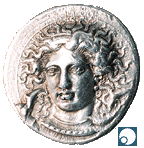

The idea for this catalogue and for the exhibition it accompanied followed
closely and naturally upon Ottilia Buerger's decision to make Lawrence University
the permanent home of her collection of ancient and Byzantine coins, for
it became immediately apparent that the exceptional breadth and quality
of the collection would permit us to explore not only the historical and
aesthetic importance of coins themselves, but also their political, religious,
economic, and artistic contexts. The central theme of the exhibition and
its catalogue is that the coins were circulated not only as means of exchange,
but also as significant bearers of meaning. Although they superficially
resemble our own coins in their depictions of heads of state, monuments,
and symbols (indeed, much modern coinage has been influenced by the traditions
established in these coins), they functioned very differently in their respective
societies. Since their intrinsic value and artistic merit made them highly
regarded objects in themselves, and since their wide circulation guaranteed
a large audience for their images, they were the most important popular
medium through which a government could communicate images characterizing
the state, or, when the state was embodied in an individual, its ruler.
Together, the exhibition and the catalogue are designed to show modern viewers
how to "read" the coins and how to see them as tiny windows through
which we may glimpse many facets of the cultures that produced them.
The exhibition and catalogue have been collaborative ventures in every sense,
and I would like to
take this opportunity to thank the people who made them possible. Over the
course of the last three years, a dedicated group of students have brought
to the study of the coins the perspectives of their respective fields of
art history, classics, history, anthropology, music, and even biology. The
catalogue entries they wrote are signed with their initials, but I would
like to acknowledge them as co-authors and to thank them here: Shannon Gaylord
Bakich (biology, '92), Robin Emmanuel Bandy (anthropology and history, '93),
Kristin J. Brainard (art history, '94), Rebecca K. Browning (art history
and philosophy, '93), Jonathan D. Greene (art history, '93), Benjamin Hayes
(classics and English, '93), Eric N. Jurgens (anthropology '93), Rebecca
H. Luhmann (art history, '93), Peter A. Martens (music education and classics,
'95), Kathleen L. Metzger (classics, '94), Malcolm Pettingell (classics,
'93), Kirsten L. Ratwik (history, '93), Timothy S. Riley (art history, '92),
and Kelly Swett (art history and anthropology, '93). Lawrence faculty have
also taken an active interest in the collection. Michael T. Orr, associate
professor of art history, Daniel J. Taylor, Hiram A. Jones Professor of
Classics, and Jere M. Wickens, adjunct assistant professor of anthropology,
contributed essays for the catalogue; I am very grateful to have had the
benefit of their historical, art historical, linguistic, and archaeological
expertise. Todd McGrain, assistant professor of art, contributed his drawing
and metal-working skills for the illustration of coin-striking. I would
also like to thank Sylvia Hurter of Bank Leu Numismatik, Thomas R. Martin
of the College of the Holy Cross, and William E. Metcalf of the American
Numismatic Society for their numismatic advice and assistance.
The staff of the Wriston Art Center Galleries designed and installed the
exhibition and assisted in countless ways in the preparation of the catalogue.
Special thanks are due Timothy Rodgers, curator of the Galleries, Edward
A. Holgate, former gallery coordinator, Pamela K. O'Donnell, gallery assistant,
Carol J. Fausak, secretary of the Art Department, and Jami Severson (art
history, '95). They had technical assistance from David L. Peltier, LeRoy
Frahm, and Wayne Krueger. Peter J. Gilbert, reference librarian, cheerfully
aided us in our searches for often obscure numismatic literature. The catalogue
was designed by Kristine Parins, who also tirelessly shepherded the manuscript
through to publication; she was assisted by Gregg Schneider. The coins were
photographed by Bradford Rochford, '92, and Image Studios, Appleton, Wisconsin.
We are grateful to John Kokoszka and Betley Armored Courier Inc. of Green
Bay, Wisconsin for services they donated. Our security consultant was Gordon
C. Schultz of Schultz Associates, Appleton.
From the beginning we have had the enthusiastic encouragement and support
of the administration of Lawrence University. I am particularly indebted
to President Richard Warch and to Gregory A. Volk, vice president for development
and external affairs, Stephen A. Hirby, director of development, and Donald
B. Stewart, director of public affairs. For generous funding of the research
and the catalogue we gratefully acknowledge Ottilia Buerger, the Westvaco
Corporation, and the Faculty Research Fund of Lawrence University. Additional
funding for the exhibition and its opening came from the University's Marguerite
Schumann Memorial Lectureship.
Finally, it is my great pleasure to thank Ottilia Buerger for sharing with
us her knowledge of the coins and for providing all of us the opportunity
to learn from them. In entrusting the collection to Lawrence, Miss Buerger
intended that the coins would contribute significantly to the education
of our students and to the cultural enrichment of the commmunity. With this
catalogue and exhibition we hope that we have begun to realize her goals.
Carol L. Lawton
Art Department
Lawrence University
[LU Home]
[Bearers of Meaning] [Contents]
[Essays] [Catalogue]
[Glossary]



All contents copyright (c) 1996.
Lawrence University
All rights reserved.




